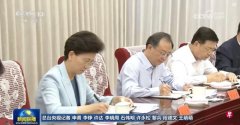All the agendas of the National People's Congress ended this morning.Chinese President ... and other national leaders left the field in the sound of military music.
.... After the Standing Committee of the State Council Li Keqiang, the Standing Committee of the Politburo Standing Committee of the Communist Party of China took the seat, and Zhou Qiang, the dean of the Supreme People's Court sitting behind him, and Zhang Jun, the dean of the Supreme People's Procuratorate, shook hands one by one.
Zhou Qiang accepted the congratulations one by one, and smiled.
People ’s Congress objected to the increase of votes through the Supreme Law Report.The National People's Congress of China passed the work report of the Supreme People's Court this morning, in favor of 2,725 votes, opposed 156 votes, and abstained from 67 votes.
In contrast, the Supreme Law Report received 2,806 votes last year, opposed 132 votes, and 23 votes. One person did not follow the voting device.
The court dean Zhou Qiang made a report on the Supreme Law on the 12th of this month. The person in charge of the Supreme Court urges the bankruptcy system to help the enterprise to return to life
Liu Guixiang, the head of the Supreme People's Court of China, emphasized yesterday that he will never say that there are old Lai Lai who is rich in the market, but the judicial organs should not over -check the enterprises facing bankruptcy. They must use the current bankruptcy system to help such enterprises to return to life.
Since the start of the Sino -US trade war last year, it continued to increase downward pressure on the Chinese economy. Many private enterprises have difficulty in operating operations or even endangered bankruptcy. Credit litigation and judicial authorities have worsened the snow in private enterprises.
Liu Guixiang Liu Guixiang, deputy ministerial committee member of the Supreme Court Judgment Committee, pointed out at the last press conference of the People's Congress yesterday afternoon that some enterprises had very good development prospects, but due to various factors such as the market, the capital chain broke.The courts and related judicial departments flock to the local government, and they took the sealing and other means.
Liu Guixiang emphasized: (judge) some measures taken cannot be regarded as no matter how three or seventeen one, and the best legal effect and social effect should be pursued.He pointed out that the court should not be sealed by the assets of corporate assets, and can only take disposal measures with the least impact on production and operation.
Liu Guixiang believes that reorganization and reconciliation can solve the debt crisis for enterprises. Once an enterprise applies for bankruptcy and reorganization, it can conduct new debt portfolio, and the entire execution procedure of the judicial organs will be suspended.He said that it is necessary to make good use of China's bankruptcy and reorganization and bankruptcy and reconciliation system to cure diseases and save people.
Jiang Bixin, deputy director of the Supreme Court, also maintained the same discussion during an interview with the Ministerial Channel yesterday, saying that it is necessary to handle private enterprise disputes in a flexible method. During the proceedings, try to use mediation methods to increase reconciliation, let private enterprises live a way, support the survival of private enterprises, and support the survival of private enterprises.develop.
Chinese officials have increased their efforts to solve the problem of dishonesty in recent years, so that Lao Lai has been lost and limited everywhere.Zhou Qiang, the director of the Supreme Court, revealed that when the work report was introduced since 2016, it was revealed that the implementation of the basic resolution of the implementation of the implementation was revealed that 3.66 million old Lai Lai was forced to automatically fulfill its obligations.The court also sentenced to 13,000 people with refusal to execute, detained 506,000 person -times, and limited 34,000 outbound, up 416.3%, 135.4%, and 54.6%year -on -year.



